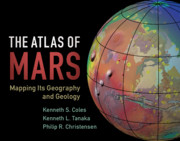Book contents
- The Atlas of Mars
- Additional material
- The Atlas of Mars
- Copyright page
- Table of Contents
- Preface
- Acknowledgments
- Abbreviations
- How to Use this Atlas
- Sources of Images
- Chapter 1 Introduction
- Chapter 2 History of Exploration of Mars
- Chapter 3 Global Character of Mars
- Chapter 4 Regional Geographic Features and Surface Views of Mars
- Chapter 5 Geology of Mars
- Map Sheets
- Mare Boreum (MC-1)
- Diacria (MC-2)
- Arcadia (MC-3)
- Mare Acidalium (MC-4)
- Ismenius Lacus (MC-5)
- Casius (MC-6)
- Cebrenia (MC-7)
- Amazonis (MC-8)
- Tharsis (MC-9)
- Lunae Palus (MC-10)
- Oxia Palus (MC-11)
- Arabia (MC-12)
- Syrtis Major (MC-13)
- Amenthes (MC-14)
- Elysium (MC-15)
- Memnonia (MC-16)
- Phoenicis Lacus (MC-17)
- Coprates (MC-18)
- Margaritifer Sinus (MC-19)
- Sinus Sabaeus (MC-20)
- Iapygia (MC-21)
- Mare Tyrrhenum (MC-22)
- Aeolis (MC-23)
- Phaethontis (MC-24)
- Thaumasia (MC-25)
- Argyre (MC-26)
- Noachis (MC-27)
- Hellas (MC-28)
- Eridania (MC-29)
- Mare Australe (MC-30)
- Moons: Phobos and Deimos
- Appendix
- Gazetteer
- References
- Index
Phoenicis Lacus (MC-17)
from Map Sheets
Published online by Cambridge University Press: 16 August 2019
- The Atlas of Mars
- Additional material
- The Atlas of Mars
- Copyright page
- Table of Contents
- Preface
- Acknowledgments
- Abbreviations
- How to Use this Atlas
- Sources of Images
- Chapter 1 Introduction
- Chapter 2 History of Exploration of Mars
- Chapter 3 Global Character of Mars
- Chapter 4 Regional Geographic Features and Surface Views of Mars
- Chapter 5 Geology of Mars
- Map Sheets
- Mare Boreum (MC-1)
- Diacria (MC-2)
- Arcadia (MC-3)
- Mare Acidalium (MC-4)
- Ismenius Lacus (MC-5)
- Casius (MC-6)
- Cebrenia (MC-7)
- Amazonis (MC-8)
- Tharsis (MC-9)
- Lunae Palus (MC-10)
- Oxia Palus (MC-11)
- Arabia (MC-12)
- Syrtis Major (MC-13)
- Amenthes (MC-14)
- Elysium (MC-15)
- Memnonia (MC-16)
- Phoenicis Lacus (MC-17)
- Coprates (MC-18)
- Margaritifer Sinus (MC-19)
- Sinus Sabaeus (MC-20)
- Iapygia (MC-21)
- Mare Tyrrhenum (MC-22)
- Aeolis (MC-23)
- Phaethontis (MC-24)
- Thaumasia (MC-25)
- Argyre (MC-26)
- Noachis (MC-27)
- Hellas (MC-28)
- Eridania (MC-29)
- Mare Australe (MC-30)
- Moons: Phobos and Deimos
- Appendix
- Gazetteer
- References
- Index
Summary
The Phoenicis Lacus quadrangle shows the heart of the Tharsis region that dominates the western hemisphere of Mars. Elevations are high: except for the floor of Valles Marineris, essentially the entire quadrangle lies above datum. Arsia Mons rises over 11 km from the surrounding plain and is more than 400 km across. It marks the southwest end of the northeast-trending Tharsis Montes, which also include Pavonis Mons and Ascraeus Mons (MC-9). The eastern half of the map is dominated by Syria, Sinai, and Solis Plana, high plateaus that are capped by a broad field of dozens of smaller volcanic shields. From Arsia Mons across Syria Planum the elevation is 6,000 m or more, descending to 2,000 m at the southwest corner of the map. Wrapping for 1,000 km around the north and west margin of Syria Planum is the Noctis Labyrinthus, where numerous canyons and depressions intersect in a maze-like pattern (see Figure 2.3 in Chapter 2). A large, rugged promontory, informally referred to as Claritas rise, lies along the southern margin of the quadrangle and east of Claritas Fossae (Dohm et al., 2009a). Valles Marineris extends east of Noctis Labyrinthus for several thousand kilometers (across MC-18).
- Type
- Chapter
- Information
- The Atlas of MarsMapping its Geography and Geology, pp. 156 - 161Publisher: Cambridge University PressPrint publication year: 2019



